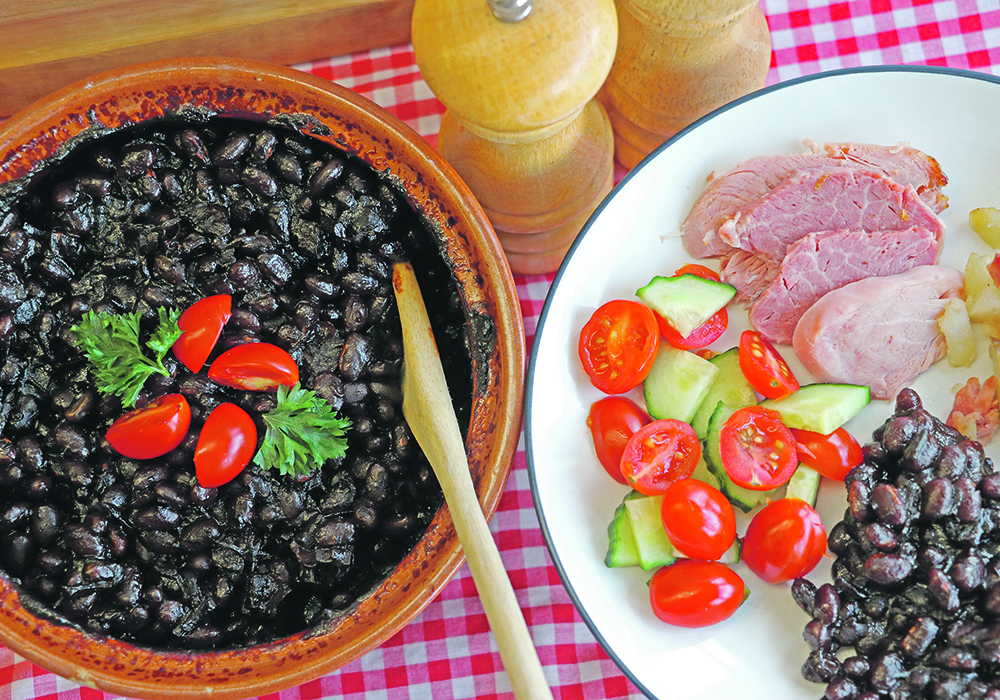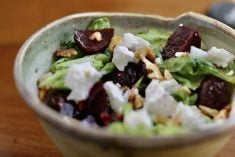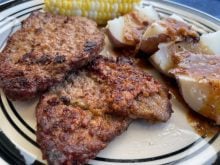Smoked pork picnic shoulder ham, or any combination of these words, is used to describe the front shoulder of pork that has been cured and smoked, the same as the back thigh or ham.
The front shoulder is more economical than the back thigh and our family finds the taste just as good. After the meat is removed, boil the bone for broth to make baked beans or soup.
Baked smoked picnic shoulder ham
When cooking ham, I’m always looking for a honey mustard glaze and I think this is about the best I have tried. Serves 10-12.
Read Also

Communication key to bridging generation gap
Each generation is shaped by the predominant forces at play during their formative years. Acknowledging these influences can improve communication among the generations.
Baking time 40-55 minutes per kilogram.
- 5 to 8 lb. smoked picnic shoulder 2.5 to 4 kg
- 3/4 c. water 175 mL
- 2 oranges, peeled
- 1 1/2 c. brown sugar 375 mL
- 1/2 c. apple cider or vinegar white 125 mL
- 1/3 c. honey 75 mL
- 1 tbsp. prepared mustard 15 mL
- 1 tbsp. grainy mustard 15 mL
- 1 tsp. ground cinnamon 5 mL
- 1 tsp. salt 5 mL
- 1/4 tsp. cayenne pepper 1 mL
Preheat oven to 350 F (180 C).
Remove wrapper and netting from meat. Place meat in a large roasting pan fat side up, add water.
Cover with foil and bake for one hour.
Remove foil and peel rind off the fat cap. Cut cross-check slits into fat and about one-half inch (1 cm) into the meat.
To make glaze, puree oranges, brown sugar, vinegar, honey, mustards, cinnamon, salt and cayenne pepper in a blender or food processor.
Brush glaze all over the picnic ham, getting into slits.
Bake for another hour, uncovered, add more glaze. Bake additional 30 minutes and reglaze. Bake until an internal temperature of 160 F (71C) is reached.
When done, fat should be starting to crisp, and glaze will be nicely caramelized. Rest meat for five to 10 minutes before carving.
Retain juice and drippings from pan, place in a container and refrigerate. Once cold remove and dispose of fat layer. The drippings can be used to make baked beans or soup. Adapted from blackpeppercorn.com.
Baked beans
The juice dripping from the baked smoked picnic ham is wonderful in these beans.
- 2 1/2 c. dry white beans 625 mL
- 6 c. water, if possible soft water 1.5 L
- 1/2 lb. bacon or ham, cubed 250 g
- 1/2 c. sweet onion, chopped 125 mL
- 1/2 c. dark brown sugar 125 mL
- 1/2 c. molasses, blackstrap is quite strong, cooking and fancy molasses are milder 125 mL
- 1 tbsp. canola oil 15 mL
- 1 tsp. dry mustard 5 mL
- 1 tsp. salt 5 mL
- 1/2 tsp. black pepper, fresh ground 2 mL
- 3 – 4 c. ham drippings or broth 750 mL – 1 L
- 1 – 5.5 fl. oz. can tomato paste 156 mL
- or 1 – 2 c. tomato juice if needed 250 – 500 mL
Pick over beans, remove small stones and broken beans, wash, put in a container and add water, cover beans with an inch (two cm) of water. Soak 12 hours or overnight (or do quick-soak method see below).
Fry bacon if desired and drain off fat.
Drain water from beans, discard water.
Put onion slices on bottom of a heavy-lidded bean pot, large casserole or crock-pot. Add beans and bacon or ham.
Mix brown sugar, molasses, oil, mustard, salt, pepper, ham broth, water and tomato paste.
Add to beans and bacon and gently mix.
Cover and bake in a 300 F (150 C) oven or in a crockpot on low for five to six hours or until beans are tender. Add more hot water or tomato juice during the baking time if needed; do not let the beans get dry. Bake uncovered for the final 30 minutes.
To rid the beans of two sugars, raffinose and stachyose, which cause flatulence, discard the water the beans were soaked in, add fresh water or broth for cooking beans.
Quick-soak method: Pick over beans and wash. Place in a large pot, add water and slowly bring to a boil. Boil gently for three minutes. Remove from heat and let stand one hour.
After soak time, drain off water and add three cups fresh water or broth and other ingredients.
To reduce flatulence
To reduce flatulence, soak beans in the boiled water at room temperature for at least four hours. Pour off soaking water and add fresh water.
Beans freeze well and can be reheated for a quick addition to a meal.
Adapted from The Amazing Legume, Cooking with Lentils, Dry Beans and Dry Peas by Alice Jenner.
Note: My beans wouldn’t soften, even with extended cooking. When the beans were squashed the centres seemed to be dry and crumbly. I discovered the most common reasons for hard beans are old, dried out, or poor-quality beans. I usually buy pre-packaged beans, but this time I bought dry beans from a bulk food store where they are stored in open bins. Beans should be stored in air-tight containers to prevent excessive drying out. Also using hard water can keep beans hard after cooking.
Pavlova nests
Small pavlovas make any easy and attractive nest dessert for Easter. The meringue base is crisp on the outside and marshmallow soft and chewy on the inside.
Add lemon curd, custard or whipped cream as a filling and top with fresh fruit.
Yield: One nine-inch pavlova or eight-to-12 individual ones.
- 3 egg whites at room temperature
- 1/8 tsp. salt 0.5 mL
- 1/4 tsp. cream of tartar 1 mL
- 1 tbsp. water 15 mL
- 1 c. very fine white sugar or berry sugar (sometimes called castor sugar) 250 mL
- 1 tbsp. cornstarch 15 mL
- 1 tsp. baking powder 5 mL
- 1 tsp. vinegar or lemon juice 5 mL
- 1 tsp. vanilla 5 mL
- use lemon curd, custard or whipped cream as a filling.
- 2 c. fresh fruit such as raspberries, blackberries, strawberries, grapes, pineapple 500 mL
Preheat oven to 300 F (150 C).
Line a cookie sheet with parchment paper. Using a plate draw a nine-inch circle on the parchment with a pencil. Or trace 12 four-inch (10 cm) circles. Turn parchment paper over so pencil markings won’t transfer to the pavlovas.
Egg whites that are at room temperature will whip more quickly and easily with a larger volume than cold eggs. Cream of tartar improves the stability and volume of egg whites.
In a large bowl, beat egg whites on high speed until foamy. Add water and beat to combine. Add 3/4 cup of sugar gradually, while continuing to beat until stiff peaks form.
Make sure sugar is completely dissolved by rubbing a little mixture between fingertips, it should be completely smooth.
Combine remaining 1/4 cup sugar, cornstarch and baking powder. Gently fold into egg whites with vinegar or lemon juice and vanilla.
Transfer egg white mixture to a cake decorating bag or pastry bag with a star tip.
Starting in the centre of the circle, pipe a base then add one or two extra rounds to create a nest shape.
For large pavlova bake at 300 F (150 C) for one hour. Turn oven off and leave meringue in oven for an additional 30 minutes.
For individual pavlova, bake at 300 F (150 C) for 15 minutes, turn oven off and leave in oven for 30 minutes. When cool, pavlova should be hard on the outside, and slightly moist inside.
Note: When making pavlova, any trace of egg yolk or grease on the bowl or beaters can prevent egg whites from reaching full volume. To avoid this, wash beaters and bowl in hot, soapy water, wiping clean with a little white vinegar and drying thoroughly.
This recipe is adapted from a New Zealand friend, Delwyn MacKenzie.
Lemon curd
This recipe is from my daughter-in-law Lydia, it was her Great-Grandma Hall’s recipe from Scotland.
- 1/4 c. butter 60 mL
- 1/3 c. sugar 75 mL
- 6 tbsp. lemon juice and zest of 2 lemons 90 mL
- 2 eggs, beaten
Melt butter and sugar together. Add lemon juice and beaten eggs. Cook over medium heat stirring constantly with a wire whisk, until thickened. Pour into sterilized jar and store in refrigerator.
Assemble the pavlova just before serving, add filling and top with fruit.
One of those days
Have you ever had one of those days when it seemed like everything went wrong? In preparing the recipes for this article, I had one of those weeks. When I made the pavlova, I forgot to reduce the cooking time for the smaller size, as a result they were slightly overcooked with a caramelized, almost burned flavour. The second batch was much better.
hen I was cooking the ham, I had a large, sweet potato cooking in the oven at 400 F. I neglected to turn the temperature lower when I put the ham in the oven, thus the glaze burned.
I cut the burned fat off, reglazed the ham and lowered the temperature.
As mentioned earlier in the article, when I was cooking the baked beans, they would not soften.
Still, all the food disappeared and was enjoyed, along with lots of laughs about my bad week.
Betty Ann Deobald is a home economist from Rosetown, Sask., and a member of Team Resources. Contact: team@producer.com.















